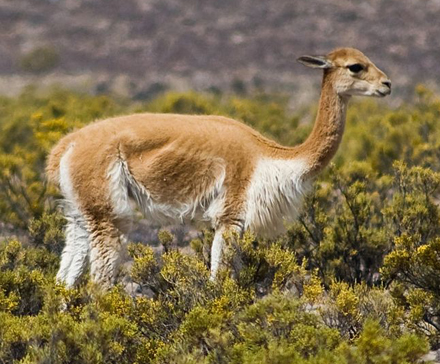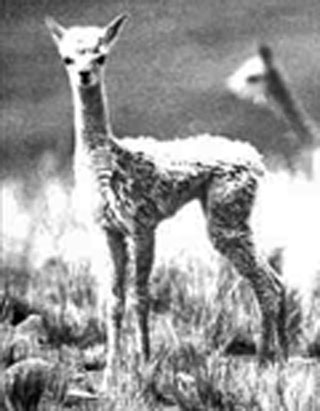Navigation
Sustaining Vicuña Populations Through Community Involvement
The vicuña is one of the most smallest South American Camelids
and is probably linked to its cousin the Alpaca. Vicuña are distributed
along five countries in South America, which include Argentina, Peru,
Bolivia, Chile and Ecuador.
 |
| A vicuña (Vicugna vicugna) grazing near Arequipa, Peru. Photo by Alexandre Buisse (Nattfodd) |
Significant update from the International Union for Conservation of Nature and Natural Resources (IUCN):
Vicugna vicugna
Country: Vicuña population
According to IUCN, as of October 23, 2012, the Vicuña population is now TOTAL: 347,273. (Source http://www.iucn.org/themes/ssc/sgs/gecs/).
Argentina: 127,072 or 72,678
Bolivia: 62,869
Chile: 16,942
Ecuador: 2,683
Peru: 188,327
“It is important to note that conservation programmes and tight control at local, national and international levels are key for the conservation of the species. Given the degree of poaching, the development of captive management schemes, economic interests for hybridizing Vicuñas and Alpacas, uncertainties about the impact of climate change on the already poor vicuna habitat, and the deterioration of grasslands due to overgrazing by domestic livestock, unless conservation actions are in place, the species might decline its numbers again.”
Location:
Ayacucho, Puno, Junin, Arequipa and Apurimac, Peru
Problem Overview:
Rapid decrease in vicuña populations, mainly caused by poaching and illegal meat commercialization in black markets.
The vicuña is one of the most smallest South American Camelids
and is probably linked to its cousin the Alpaca. Vicuña are distributed
along five countries in South America, which include Argentina, Peru,
Bolivia, Chile and Ecuador.
In the Case of Peru, the vicuña extends from far north Cajamarca, to
as far south as Puno and Tacna, covering the Punas of 16 departments of Peru.
Nowadays, this very beautiful animal possesses the finest, and most expensive, animal fiber in the world. Its wool weighs only 200g, with 90% fine fibers of 12.5 um of thickness.
Sustainable Use
 |
| Vicuña Photo by Dourejeanni |
It has been estimated that the total population of vicuña prior to Spanish conquest was about 2 million head; at present this total population has been reduced to a third of the original. This is the reason why, in the 1960's, the Government of Peru initiated a tremendous effort to recover the Vicuña population. The first National Reserve was established in Pampa Galeras. According to 1969 census, the population was only 10,000 vicuñas.
This reserve was established in 1966, through agreements with the Local communities of Lucanas, department of Ayacucho, who ceded 6,500 hectares of their land. In exchange for removing all their personal belongings, livestock and destroying all permanent corrals, the Lucanas community were to receive jobs and public projects for school construction and deforestation.
By the time the agreement was signed, there were ten other campesino communities involved in the project, increasing the area of 6,500 hectares to 75,000 hectares.
Conservation activities in Pampa Galeras were initially conducted under
strict protectionist policy. In 1972, the reserve received support from
the German Federal Government to conduct research, build infrastructure and establish a vigilance system through armed guards patrolling the 6,500 hectare core management. During the first years the population growth averaged 21 percent; however, by the mid 1970's a negative population growth of 11.3% was detected, mainly caused by prolonged droughts and overgrazing.
Under this crisis, culling of excess of males was undertaken in 1977 (120 head) and in 1978 (400 head). This decision placed the new director of the Ministry of Agriculture in conflict with a radical conservationist, and set the course for many bitter discussions.
In 1991, the new Director, Antonio Brack, approved the Project for Rational Utilization of the vicuña in response to the necessities and complaints of local communities. They claimed: not to have other lands on which to raise their animals; that the government failed to accomplish its commitments on jobs generation, education, and infrastructure; and that they had no voice in policy formulation or implementation.
The project suggested a new approach towards conservation of the species, by making rational use of the vicuña through:
- Local community participation
- Technology transfer to the Andean campesino for effective management of the vicuña
- Generation and organization of legal markets for vicuña wool (based on live shearing of vicuña)
- Implementation of housing, health and education programs in the Campesino Communities involved in the project. Moreover, revenue generated by the legal commercialization of the vicuña wool would generate additional productive activities for the well-being of the population.
From 1994 to the present, the communities have improved their organization skills allowing them to make sustainable use of vicuña, reinforced by a better international market for vicuña fiber, and the halt of illegal poaching.
From 1994 to 1998 there has been an annual average increase in total
of 17.26% in total population. In 1995, the government approved a law granting communities the right to manage the land used by the vicuñas, and penalizing illegal game practices.
Local communities have been able to export 2,000 kg of Vicuña Wool (produced between 1987 and 1993), while in 1996 they were able to export 3,000 kg produced from 1994 to 1995). In July 1998 the total export was 2,500 kg. The price for vicuña wool currently ranges between $300 US and $350 US per kilo).
The follow up strategy involves participation of more than one entity: Communal Committees (Comites Comunales), park guards, and a group of specialists against illegal game are responsible for the protection of the vicuña in these designated areas. This program is financed and managed by the CONACS with support from the National Policy Department (Policía Nacional).
Initially, the vicuña have been managed in the wild. When the fiber is
needed they are captured temporarily (with the aid of nets) and sheared. All of the vicuña are contained in a perimeter of 3,000 m of fence with poles.
Nowadays, CONACS is implementing its new "Módulos de Uso Sustentable de la Vicuña (Modules for Vicuña Sustainable Use), creating, with an total extension of 1,000 hectares, cages with metal fences (1.80m) containing more than 250 vicuñas.
One of key factors in the success of the project has been the opening
of international markets to vicuña fiber, which was made possible in November 1994 at the Convention on International Trade in Endangered Species (CITES). Peru was placed in Appendix II of the Convention, becoming effective on February 16th 1995. This allows international commerce in vicuña fiber and cloth produced from live shorn animals.
Submitted by:
Consejo Nacional de Camélidos Sudamericanos (CONACS)
Fax: +51-14-710555
Tel: +51-12-655730
CONACS
Jr. Cahuide 805 - Piso 10, Jesús María
Lima 11
Peru
Domingo Hoces
Technical Director
Conacs@amauta.rcp.net.pe
Antonio Tovar
Professor
Universidad Agraria la Molina
Fax: +51-13-492041
Tel: +51-13-495669 Peru
Information Date: 1997-01-01
Information Source: Domingo Hoces, Consejo Nacional de Camélidos
Sudamericanos (CONACS); Director Email: conacs@amauta.rcp.net.pe
This case study has been based on information provided by Antonio Tovar in behalf of Dr. Domingo Hoces.
Search
Latest articles
Agriculture
- World Water Week: Healthy ecosystems essential to human health: from coronavirus to malnutrition Online session Wednesday 24 August 17:00-18:20
- World Water Week: Healthy ecosystems essential to human health: from coronavirus to malnutrition Online session Wednesday 24 August 17:00-18:20
Air Pollution
- "Water and Sanitation-Related Diseases and the Changing Environment: Challenges, Interventions, and Preventive Measures" Volume 2 Is Now Available
- Global Innovation Exchange Co-Created by Horizon International, USAID, Bill and Melinda Gates Foundation and Others
Biodiversity
- It is time for international mobilization against climate change
- World Water Week: Healthy ecosystems essential to human health: from coronavirus to malnutrition Online session Wednesday 24 August 17:00-18:20
Desertification
- World Water Week: Healthy ecosystems essential to human health: from coronavirus to malnutrition Online session Wednesday 24 August 17:00-18:20
- UN Food Systems Summit Receives Over 1,200 Ideas to Help Meet Sustainable Development Goals
Endangered Species
- Mangrove Action Project Collaborates to Restore and Preserve Mangrove Ecosystems
- Coral Research in Palau offers a “Glimmer of Hope”
Energy
- Global Innovation Exchange Co-Created by Horizon International, USAID, Bill and Melinda Gates Foundation and Others
- Wildlife Preservation in Southeast Nova Scotia
Exhibits
- Global Innovation Exchange Co-Created by Horizon International, USAID, Bill and Melinda Gates Foundation and Others
- Coral Reefs
Forests
- NASA Satellites Reveal Major Shifts in Global Freshwater Updated June 2020
- Global Innovation Exchange Co-Created by Horizon International, USAID, Bill and Melinda Gates Foundation and Others
Global Climate Change
- It is time for international mobilization against climate change
- It is time for international mobilization against climate change
Global Health
- World Water Week: Healthy ecosystems essential to human health: from coronavirus to malnutrition Online session Wednesday 24 August 17:00-18:20
- More than 400 schoolgirls, family and teachers rescued from Afghanistan by small coalition
Industry
- "Water and Sanitation-Related Diseases and the Changing Environment: Challenges, Interventions, and Preventive Measures" Volume 2 Is Now Available
- Global Innovation Exchange Co-Created by Horizon International, USAID, Bill and Melinda Gates Foundation and Others
Natural Disaster Relief
- STOP ATTACKS ON HEALTH CARE IN UKRAINE
- Global Innovation Exchange Co-Created by Horizon International, USAID, Bill and Melinda Gates Foundation and Others
News and Special Reports
- World Water Week: Healthy ecosystems essential to human health: from coronavirus to malnutrition Online session Wednesday 24 August 17:00-18:20
- STOP ATTACKS ON HEALTH CARE IN UKRAINE
Oceans, Coral Reefs
- World Water Week: Healthy ecosystems essential to human health: from coronavirus to malnutrition Online session Wednesday 24 August 17:00-18:20
- Mangrove Action Project Collaborates to Restore and Preserve Mangrove Ecosystems
Pollution
- Zakaria Ouedraogo of Burkina Faso Produces Film “Nzoue Fiyen: Water Not Drinkable”
- "Water and Sanitation-Related Diseases and the Changing Environment: Challenges, Interventions, and Preventive Measures" Volume 2 Is Now Available
Population
- "Water and Sanitation-Related Diseases and the Changing Environment: Challenges, Interventions, and Preventive Measures" Volume 2 Is Now Available
- "Water and Sanitation-Related Diseases and the Changing Environment: Challenges, Interventions, and Preventive Measures" Volume 2 Is Now Available
Public Health
- Honouring the visionary behind India’s sanitation revolution
- Honouring the visionary behind India’s sanitation revolution
Rivers
- World Water Week: Healthy ecosystems essential to human health: from coronavirus to malnutrition Online session Wednesday 24 August 17:00-18:20
- Mangrove Action Project Collaborates to Restore and Preserve Mangrove Ecosystems
Sanitation
- Honouring the visionary behind India’s sanitation revolution
- Honouring the visionary behind India’s sanitation revolution
Toxic Chemicals
- "Water and Sanitation-Related Diseases and the Changing Environment: Challenges, Interventions, and Preventive Measures" Volume 2 Is Now Available
- Actions to Prevent Polluted Drinking Water in the United States
Transportation
- "Water and Sanitation-Related Diseases and the Changing Environment: Challenges, Interventions, and Preventive Measures" Volume 2 Is Now Available
- Urbanization Provides Opportunities for Transition to a Green Economy, Says New Report
Waste Management
- Honouring the visionary behind India’s sanitation revolution
- Honouring the visionary behind India’s sanitation revolution
Water
- Honouring the visionary behind India’s sanitation revolution
- Honouring the visionary behind India’s sanitation revolution
Water and Sanitation
- Honouring the visionary behind India’s sanitation revolution
- Honouring the visionary behind India’s sanitation revolution

